卡尔曼滤波器介绍外文翻译
卡尔曼滤波器KalmanFilter
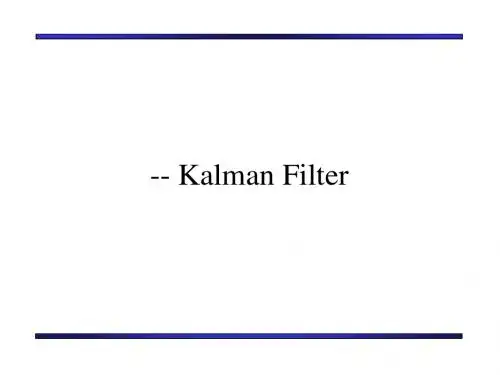
ˆ(k 1 | k ))(x(k 1) x ˆ(k 1 | k ))T P(k 1 | k ) E ( x(k 1) x
Kalman Filter Introduction
Continuing Step 1
To make life a little easier, lets shift notation slightly:
x ( k ) is the n - dimensional state vector (unknown) u( k ) is the m - dimensional input vector (known) y ( k ) is the p - dimensional output vector (known, measured) F ( k ), G ( k ), H ( k ) are appropriately dimensioned system matrices (known) v ( k ), w( k ) are zero - mean, white Gaussian noise with (known) covariance matrices Q( k ), R ( k )
1 2 P
1 ˆ )T P 1 ( x x ˆ ) ( x x e2
ˆ x
x
The most probablex is the one that : ˆx ˆ x 1. satisfiesx 2. minimizes xT P 1x
Kalman Filter Introduction
T ˆk ˆk Pk 1 E ( xk 1 x 1 )( xk 1 x 1 )
卡尔曼滤波器介绍之欧阳光明创编
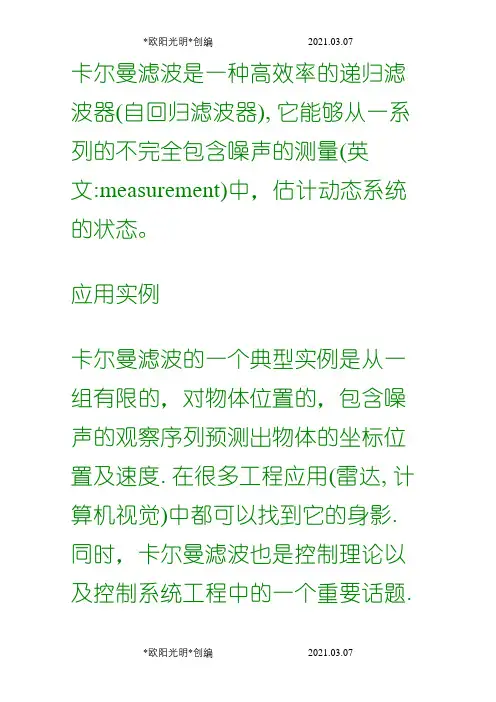
卡尔曼滤波是一种高效率的递归滤波器(自回归滤波器), 它能够从一系列的不完全包含噪声的测量(英文:measurement)中,估计动态系统的状态。
应用实例卡尔曼滤波的一个典型实例是从一组有限的,对物体位置的,包含噪声的观察序列预测出物体的坐标位置及速度. 在很多工程应用(雷达, 计算机视觉)中都可以找到它的身影. 同时,卡尔曼滤波也是控制理论以及控制系统工程中的一个重要话题.比如,在雷达中,人们感兴趣的是跟踪目标,但目标的位置,速度,加速度的测量值往往在任何时候都有噪声.卡尔曼滤波利用目标的动态信息,设法去掉噪声的影响,得到一个关于目标位置的好的估计。
这个估计可以是对当前目标位置的估计(滤波),也可以是对于将来位置的估计(预测),也可以是对过去位置的估计(插值或平滑).命名这种滤波方法以它的发明者鲁道夫.E.卡尔曼(Rudolf E. Kalman)命名. 虽然Peter Swerling实际上更早提出了一种类似的算法.斯坦利.施密特(Stanley Schmidt)首次实现了卡尔曼滤波器.卡尔曼在NASA埃姆斯研究中心访问时,发现他的方法对于解决阿波罗计划的轨道预测很有用,后来阿波罗飞船的导航电脑使用了这种滤波器. 关于这种滤波器的论文由Swerling (1958), Kalman (1960)与 Kalman and Bucy (1961)发表.目前,卡尔曼滤波已经有很多不同的实现.卡尔曼最初提出的形式现在一般称为简单卡尔曼滤波器.除此以外,还有施密特扩展滤波器,信息滤波器以及很多Bierman, Thornton 开发的平方根滤波器的变种.也行最常见的卡尔曼滤波器是锁相环,它在收音机,计算机和几乎任何视频或通讯设备中广泛存在.欧阳光明(2021.03.07)卡尔曼滤波器– Kalman Filter1.什么是卡尔曼滤波器(What is the Kalman Filter )在学习卡尔曼滤波器之前,首先看看为什么叫“卡尔曼”。
卡尔曼滤波器介绍
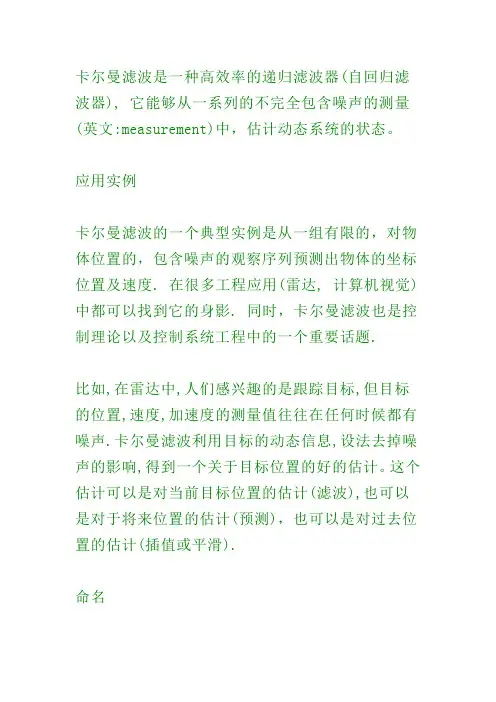
卡尔曼滤波是一种高效率的递归滤波器(自回归滤波器), 它能够从一系列的不完全包含噪声的测量(英文:measurement)中,估计动态系统的状态。
应用实例卡尔曼滤波的一个典型实例是从一组有限的,对物体位置的,包含噪声的观察序列预测出物体的坐标位置及速度. 在很多工程应用(雷达, 计算机视觉)中都可以找到它的身影. 同时,卡尔曼滤波也是控制理论以及控制系统工程中的一个重要话题.比如,在雷达中,人们感兴趣的是跟踪目标,但目标的位置,速度,加速度的测量值往往在任何时候都有噪声.卡尔曼滤波利用目标的动态信息,设法去掉噪声的影响,得到一个关于目标位置的好的估计。
这个估计可以是对当前目标位置的估计(滤波),也可以是对于将来位置的估计(预测),也可以是对过去位置的估计(插值或平滑).命名这种滤波方法以它的发明者鲁道夫.E.卡尔曼(Rud olf E. Kalman)命名. 虽然Peter Swerling实际上更早提出了一种类似的算法.斯坦利.施密特(Stanley Schmidt)首次实现了卡尔曼滤波器.卡尔曼在NASA埃姆斯研究中心访问时,发现他的方法对于解决阿波罗计划的轨道预测很有用,后来阿波罗飞船的导航电脑使用了这种滤波器.关于这种滤波器的论文由Swerling (1958), Kalm an (1960)与 Kalman and Bucy (1961)发表.目前,卡尔曼滤波已经有很多不同的实现.卡尔曼最初提出的形式现在一般称为简单卡尔曼滤波器.除此以外,还有施密特扩展滤波器,信息滤波器以及很多Bierman, Thornton 开发的平方根滤波器的变种.也行最常见的卡尔曼滤波器是锁相环,它在收音机,计算机和几乎任何视频或通讯设备中广泛存在.卡尔曼滤波器– Kalman Filter1.什么是卡尔曼滤波器(What is the Kalman Filter )在学习卡尔曼滤波器之前,首先看看为什么叫“卡尔曼”。
【译】图解卡尔曼滤波(KalmanFilter)
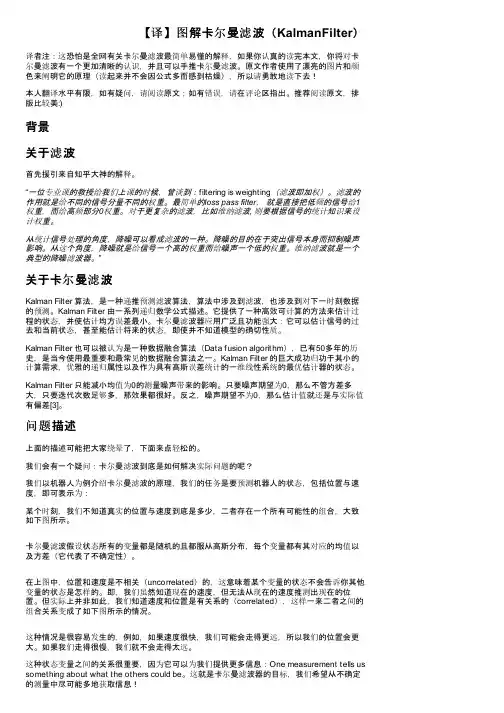
【译】图解卡尔曼滤波(KalmanFilter)译者注:这恐怕是全网有关卡尔曼滤波最简单易懂的解释,如果你认真的读完本文,你将对卡尔曼滤波有一个更加清晰的认识,并且可以手推卡尔曼滤波。
原文作者使用了漂亮的图片和颜色来阐明它的原理(读起来并不会因公式多而感到枯燥),所以请勇敢地读下去!本人翻译水平有限,如有疑问,请阅读原文;如有错误,请在评论区指出。
推荐阅读原文,排版比较美:)背景关于滤波首先援引来自知乎大神的解释。
“一位专业课的教授给我们上课的时候,曾谈到:filtering is weighting(滤波即加权)。
滤波的作用就是给不同的信号分量不同的权重。
最简单的loss pass filter,就是直接把低频的信号给1权重,而给高频部分0权重。
对于更复杂的滤波,比如维纳滤波, 则要根据信号的统计知识来设计权重。
从统计信号处理的角度,降噪可以看成滤波的一种。
降噪的目的在于突出信号本身而抑制噪声影响。
从这个角度,降噪就是给信号一个高的权重而给噪声一个低的权重。
维纳滤波就是一个典型的降噪滤波器。
”关于卡尔曼滤波Kalman Filter 算法,是一种递推预测滤波算法,算法中涉及到滤波,也涉及到对下一时刻数据的预测。
Kalman Filter 由一系列递归数学公式描述。
它提供了一种高效可计算的方法来估计过程的状态,并使估计均方误差最小。
卡尔曼滤波器应用广泛且功能强大:它可以估计信号的过去和当前状态,甚至能估计将来的状态,即使并不知道模型的确切性质。
Kalman Filter 也可以被认为是一种数据融合算法(Data fusion algorithm),已有50多年的历史,是当今使用最重要和最常见的数据融合算法之一。
Kalman Filter 的巨大成功归功于其小的计算需求,优雅的递归属性以及作为具有高斯误差统计的一维线性系统的最优估计器的状态。
Kalman Filter 只能减小均值为0的测量噪声带来的影响。
卡尔曼滤波英文版
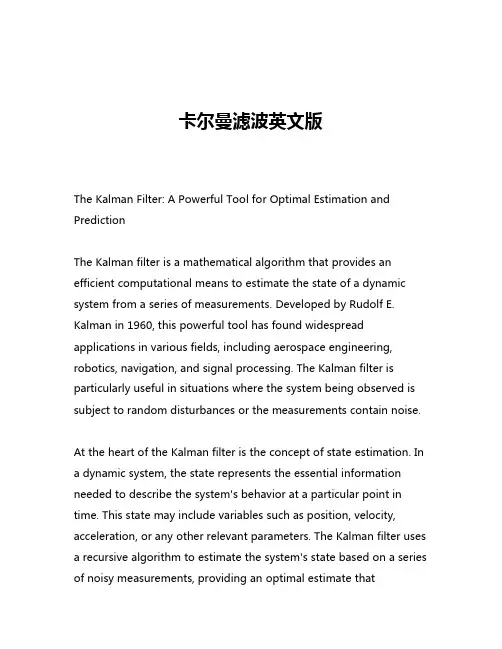
卡尔曼滤波英文版The Kalman Filter: A Powerful Tool for Optimal Estimation and PredictionThe Kalman filter is a mathematical algorithm that provides an efficient computational means to estimate the state of a dynamic system from a series of measurements. Developed by Rudolf E. Kalman in 1960, this powerful tool has found widespread applications in various fields, including aerospace engineering, robotics, navigation, and signal processing. The Kalman filter is particularly useful in situations where the system being observed is subject to random disturbances or the measurements contain noise.At the heart of the Kalman filter is the concept of state estimation. In a dynamic system, the state represents the essential information needed to describe the system's behavior at a particular point in time. This state may include variables such as position, velocity, acceleration, or any other relevant parameters. The Kalman filter uses a recursive algorithm to estimate the system's state based on a series of noisy measurements, providing an optimal estimate thatminimizes the mean square error.The Kalman filter operates in two distinct phases: the prediction phase and the update phase. In the prediction phase, the algorithm uses the system's dynamics and the previous state estimate to predict the current state. This prediction is then combined with the current measurement in the update phase, where the Kalman filter calculates a weighted average of the predicted state and the measured state. The weighting factor, known as the Kalman gain, is determined based on the relative uncertainties of the prediction and the measurement.One of the key advantages of the Kalman filter is its ability to handle uncertainty and noise in the system and measurements. By continuously updating the state estimate based on the available measurements, the Kalman filter can effectively filter out the noise and provide a smooth, accurate estimate of the system's state. This makes the Kalman filter particularly useful in applications where the measurements are unreliable or subject to various sources of noise, such as sensor errors, environmental disturbances, or measurement delays.Another important aspect of the Kalman filter is its recursive nature. Instead of storing and processing all past measurements, the Kalman filter only requires the current measurement and the previous stateestimate to compute the current state estimate. This makes the algorithm computationally efficient and well-suited for real-time applications, where the system's state needs to be estimated and updated continuously.The versatility of the Kalman filter has led to its widespread adoption in a variety of applications. In the field of aerospace engineering, the Kalman filter is extensively used for aircraft and spacecraft navigation, guidance, and control. By combining measurements from multiple sensors, such as GPS, inertial measurement units, and radar, the Kalman filter can provide a robust and accurate estimate of the vehicle's position, orientation, and velocity.In the field of robotics, the Kalman filter is used to track the position and orientation of mobile robots, enabling them to navigate through complex environments and perform tasks with high precision. In signal processing, the Kalman filter is employed to remove noise and distortion from various types of signals, such as audio, video, and communication signals, improving the quality and clarity of the output.Beyond these traditional applications, the Kalman filter has also found use in emerging areas like autonomous vehicles, where it plays a crucial role in fusing data from multiple sensors (e.g., cameras, lidar, radar) to provide a comprehensive understanding of the vehicle'ssurroundings and enable accurate localization, mapping, and decision-making.The widespread adoption of the Kalman filter is a testament to its mathematical elegance and practical effectiveness. The algorithm's ability to provide optimal state estimates in the presence of uncertainty and noise has made it an indispensable tool in a wide range of fields, from aerospace to robotics and beyond.As technology continues to advance, the Kalman filter is likely to remain a fundamental component in many complex systems, enabling more accurate, reliable, and efficient solutions to a myriad of real-world problems. Its ongoing evolution and integration with emerging technologies, such as deep learning and sensor fusion, are likely to unlock even greater capabilities and applications in the years to come.。
卡尔曼滤波
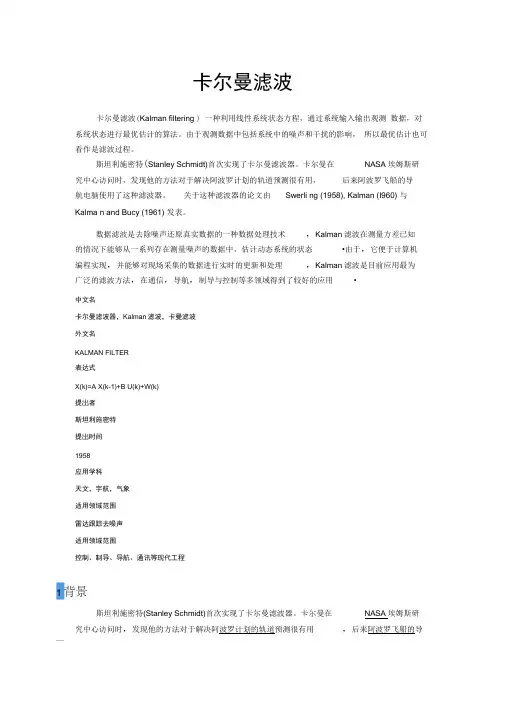
卡尔曼滤波卡尔曼滤波(Kalman filtering ) 一种利用线性系统状态方程,通过系统输入输出观测数据,对系统状态进行最优估计的算法。
由于观测数据中包括系统中的噪声和干扰的影响,所以最优估计也可看作是滤波过程。
斯坦利施密特(Stanley Schmidt)首次实现了卡尔曼滤波器。
卡尔曼在NASA埃姆斯研究中心访问时,发现他的方法对于解决阿波罗计划的轨道预测很有用,后来阿波罗飞船的导航电脑使用了这种滤波器。
关于这种滤波器的论文由Swerli ng (1958), Kalman (I960) 与Kalma n and Bucy (1961) 发表。
数据滤波是去除噪声还原真实数据的一种数据处理技术,Kalman滤波在测量方差已知的情况下能够从一系列存在测量噪声的数据中,估计动态系统的状态•由于,它便于计算机编程实现,并能够对现场采集的数据进行实时的更新和处理,Kalman滤波是目前应用最为广泛的滤波方法,在通信,导航,制导与控制等多领域得到了较好的应用•中文名卡尔曼滤波器,Kalman滤波,卡曼滤波外文名KALMAN FILTER表达式X(k)=A X(k-1)+B U(k)+W(k)提岀者斯坦利施密特提岀时间1958应用学科天文,宇航,气象适用领域范围雷达跟踪去噪声适用领域范围控制、制导、导航、通讯等现代工程斯坦利施密特(Stanley Schmidt)首次实现了卡尔曼滤波器。
卡尔曼在NASA埃姆斯研究中心访问时,发现他的方法对于解决阿波罗计划的轨道预测很有用,后来阿波罗飞船的导—航电脑使用了这种滤波器。
关于这种滤波器的论文由Swerling (1958), Kalman (1960)与Kalma n and Bucy (1961) 发表。
2定义传统的滤波方法,只能是在有用信号与噪声具有不同频带的条件下才能实现. 20世纪40年代,N .维纳和A. H .柯尔莫哥罗夫把信号和噪声的统计性质引进了滤波理论,在假设信号和噪声都是平稳过程的条件下,利用最优化方法对信号真值进行估计,达到滤波目的,从而在概念上与传统的滤波方法联系起来,被称为维纳滤波。
经典资料|卡尔曼滤波算法及其在自动驾驶导航方面的应用
假设信号和噪声都是平稳过程的条件下,利用最优化方法对信号真值进行估计,达到滤波 目的,从而在概念上与传统的滤波方法联系起来,被称为维纳滤波。这种方法要求信号和 噪声都必须是以平稳过程为条件。60 年代初,卡尔曼(R.E.Kalman)和布塞(R. S.Bucy) 发表了一篇重要的论文《线性滤波和预测 理论的新成果》,提出了一种新的线性滤波和 预测理由论,被称之为卡尔曼滤波。特点是在线性状态空间表示的基础上对有噪声的输入 和观测信号进行处理,求取系统状态或真实信号。
扩展卡尔曼滤波(EXTEND KALMAN FILTER, EKF) 扩展卡尔曼滤波器
是由 kalman filter 考虑时间非线性的动态系统,常应用于目标跟踪系统。
状态估计
状态估计是卡尔曼滤波的重要组成部分。一般来说,根据观测数据对随机量进行定量推 断就是估计问题,特别是对动态行为的状态估计,它能实现实时运行状态的估计和预测功 能。比如对飞行器状态估计。状态估计对于了解和控制一个系统具有重要意义,所应用的 方法属于统计学中的估计理论。最常用的是最小二乘估计,线性最小方差估计、最小方差 估计、递推最小二乘估计等。其他如风险准则的贝叶斯估计、最大似然估计、随机逼近等 方法也都有应用。
状态量
受噪声干扰的状态量是个随机量,不可能测得精确值,但可对它进行一系列观测,并依 据一组观测值,按某种统计观点对它进行估计。使估计值尽可能准确地接近真实值,这就 是最优估计。真实值与估计值之差称为估计误差。若估计值的数学期望与真实值相等,这 种估计称为无偏估计。卡尔曼提出的递推最优估计理论,采用状态空间描述法,在算法采 用递推形式,卡尔曼滤波能处理多维和非平稳的随机过程。
这种理论是在时间域上来表述的,基本的概念是:在线性系统的状态空间表示基础上, 从输出和输入观测数据求系统状态的最优估计。这里所说的系统状态,是总结系统所有过 去的输入和扰动对系统的作用的最小参数的集合,知道了系统的状态就能够与未来的输入 与系统的扰动一起确定系统的整个行为。
kalman_intro卡尔曼滤波介绍原文
The Kalman filter addresses the general problem of trying to estimate the state x ∈ ℜ of a discrete-time controlled process that is governed by the linear stochastic difference equation x k = Ax k – 1 + Bu k – 1 + w k – 1 , zk = H xk + vk . with a measurement z ∈ ℜ that is
n
UNC-Chapel Hill, TR 95-041, April 5, 2004
Welch & Bishop, An Introduction to the Kalman Filter
3
The a priori estimate error covariance is then Pk = E [ ek ek ] , and the a posteriori estimate error covariance is
均方误差
1. welch@, /~welch 2. gb@, /~gb
Welch & Bishop, An Introduction to the Kalman Filter
Abstract
In 1960, R.E. Kalman published his famous paper describing a recursive solution to the discrete-data linear filtering problem. Since that time, due in large part to advances in digital computing, the Kalman filter has been the subject of extensive research and application, particularly in the area of autonomous or assisted navigation. The Kalman filter is a set of mathematical equations that provides an efficient computational (recursive) means to estimate the state of a process, in a way that minimizes the mean of the squared error. The filter is very powerful in several aspects: it supports estimations of past, present, and even future states, and it can do so even when the precise nature of the modeled system is unknown. The purpose of this paper is to provide a practical introduction to the discrete Kalman filter. This introduction includes a description and some discussion of the basic discrete Kalman filter, a derivation, description and some discussion of the extended Kalman filter, and a relatively simple (tangible) example with real numbers & results. 注:本文的目的是提供一份关于离散滤波器的实用介绍。本介绍包括基本离 散滤波器的介绍及一些讨论,其来源,描述及扩展滤波器的讨论,以及一份 真实案例的分析讨论。
kalman filter 的英文术语
kalman filter 的英文术语Kalman Filter(卡尔曼滤波器)是一种高效且递归的滤波器,用于估计线性动态系统的状态。
该算法由匈牙利数学家Rudolf Kalman于20世纪60年代提出,并已广泛应用于航空航天、无人驾驶、金融预测、机器人技术、传感器融合、计算机视觉等众多领域。
Key Terms and Concepts of Kalman Filter:State Estimation: The process of determining the most likely state of a system based on a set of observations. In Kalman Filter, this is achieved by combining the system's predicted state with the actual measurements.System Model: A mathematical representation of the system's behavior. It typically consists of a state equation and an observation equation. The state equation describes how the state evolves over time, while the observation equation defines how the state is related to the measurements.State Variables: The internal variables that describe the system's state at any given time. These variables are estimated using the Kalman Filter.Process Noise: Uncertainty in the system model that cannot be explained by the measurements. It represents the noise or uncertainty in the system's dynamics.Measurement Noise: Uncertainty in the measurements caused by various factors such as sensor errors, environmental disturbances, etc.Covariance Matrix: A matrix that quantifies the uncertainty associated with the estimated state variables. It is used to track the uncertainty and adjust the filter's estimates accordingly.Prediction Step: The process of estimating the system's state at the next time step based on the current state and the system model. This step involves applying the state equation to predict the next state and updating the covariance matrix.Update Step: The process of correcting the predicted state based on the actual measurements. This step involves calculating the Kalman gain, which determines how much to trust the measurements relative to the predictions, and then updating the state estimate and covariance matrix accordingly.The Kalman Filter algorithm iterates between these prediction and update steps, continuously improving the state estimation as new measurements become available. Its recursive nature allows it to process data in real-time, making it an ideal choice for many real-world applications.。
关于卡尔曼滤波的解释
现在我们已经得到k时刻的最优温度值了,下一步就是要进入k+1时刻,进行新的最优估算。到现在为止,好像还没看到什么自回归的东西出现。对了,在进入k+1时刻之前,我们还要算出k时刻那个最优值(24.56度)的偏差。算法如下:((1-Kg)*5^2)^0.5=2.35。这里的5就是上面的k时刻你预测的那个23度温度值的偏差,得出的2.35就是进入k+1时刻以后k时刻估算出的最优温度值的偏差(对应于上面的3)。
该系统的真实温度为25度,图中用黑线表示。图中红线是卡尔曼滤波器输出的最优化结果(该结果在算法中设置了Q=1e-6,R=1e-1)。
简单来说,卡尔曼滤波器是一个“optimal recursive data processing algorithm(最优化自回归数据处理算法)”。对于解决很大部分的问题,他是最优,效率最高甚至是最有用的。他的广泛应用已经超过30年,包括机器人导航,控制,传感器数据融合甚至在军事方面的雷达系统以及导_弹追踪等等。近年来更被应用于计算机图像处理,例如头脸识别,图像分割,图像边缘检测等等。
就是这样,卡尔曼滤波器就不断的把covariance递归,从而估算出最优的温度值。他运行的很快,而且它只保留了上一时刻的covariance。上面的Kg,就是卡尔曼增益(Kalman Gain)。他可以随不同的时刻而改变他自己的值,是不是很神奇!
下面就要言归正传,讨论真正工程系统上的卡尔曼。
关于卡尔曼滤波的解释。正在看,大家看看。
1. 什么是卡尔曼滤波器
(What is the Kalman Filter?)
在学习卡尔曼滤波器之前,首先看看为什么叫“卡尔曼”。跟其他著名的理论(例如傅立叶变换,泰勒级数等等)一样,卡尔曼也是一个人的名字,而跟他们不同的是,他是个现代人!
- 1、下载文档前请自行甄别文档内容的完整性,平台不提供额外的编辑、内容补充、找答案等附加服务。
- 2、"仅部分预览"的文档,不可在线预览部分如存在完整性等问题,可反馈申请退款(可完整预览的文档不适用该条件!)。
- 3、如文档侵犯您的权益,请联系客服反馈,我们会尽快为您处理(人工客服工作时间:9:00-18:30)。
毕业设计(论文)外文资料翻译
系 : 电气工程学院
专 业: 电子信息科学与技术 姓 名: 周景龙 学 号: 0601030115 外文出处: Department of Computer Science University of North Carolina at Chapel Hill
Chapel Hill,NC27599-3175 附 件:1.外文资料翻译译文;2.外文原文。
(用外文写)
卡尔曼滤波器介绍
摘要
在1960年,卡尔曼出版了他最著名的论文,描述了一个对离散数据线性滤波问题的递归解决方法。
从那以后,由于数字计算的进步,卡尔曼滤波器已经成为广泛研究和应用的主题,特别在自动化或协助导航领域。
卡尔曼滤波器是一系列方程式,提供了有效的计算(递归)方法去估计过程的状态,是一种以平方误差的均值达到最小的方式。
滤波器在很多方面都很强大:它支持过去,现在,甚至将来状态的估计,而且当系统的确切性质未知时也可以做。
这篇论文的目的是对离散卡尔曼滤波器提供一个实际介绍。
这次介绍包括对基本离散卡尔曼滤波器推导的描述和一些讨论,扩展卡尔曼滤波器的描述和一些讨论和一个相对简单的(切实的)实际例子。
离散卡尔曼滤波器
在1960年,卡尔曼出版了他最著名的论文,描述了一个对离散数据线性滤波问题的递归解决方法[Kalman60]。
从那以后,由于数字计算的进步,卡尔曼滤波器已经成为广泛研究和应用的主题,特别在自动化或协助导航领域。
第一章讲述了对卡尔曼滤波器非常“友好的”介绍[Maybeck79],而一个完整的介绍可以在[Sorenson70]找到,也包含了一些有趣的历史叙事。
更加广泛的参考包括Gelb74;Grewal93;Maybeck79;Lewis86;Brown92;Jacobs93].
被估计的过程
卡尔曼滤波器卡用于估计离散时间控制过程的状态变量
n x ∈ℜ。
这个离散
时间过程由以下离散随机差分方程描述: 111k k k k x Ax bu w ---=++ (1.1)
测量值m z ∈ℜ,k k k z Hx v =+ (1.2) 随机变量k w 和k v 分别表示过程和测量噪声。
他们之间假设是独立的,正态分布的高斯白噪: ()~(0)p w N Q
, (1.3) ()~(0)p v N R , (1.4)
在实际系统中,过程噪声协方差矩阵Q 和观测噪声协方差矩阵R 可能会随每次迭代计算而变化。
但在这儿我们假设它们是常数。
当控制函数1k u - 或过程噪声1k w -为零时,差分方程1.1中的n n ⨯ 阶增益矩阵A 将过去k-1 时刻状态和现在的k 时刻状态联系起来。
实际中A 可能随时间变化,但
在这儿假设为常数。
n l ⨯ 阶矩阵B 代表可选的控制输入l
u ∈ℜ 的增益。
测量方程1.2中的m n ⨯ 阶矩阵H 表示状态变量k x 对测量变量k z 的增益。
实际中H 可能随
时间变化,但在这儿假设为常数。
滤波器的计算原型
我们定义_n k x ∧∈ℜ( -代表先验,^代表估计)为在已知第k 步以前的状态情况
下,第k 步的先验状态估计。
定义n k x ∧
∈ℜ为已知测量变量k z 时第k 步的后验状态
估计。
由此定义先验估计误差和后验估计误差: _k k k e x x ∧-
≡-
k k k e x x ∧
≡-
先验估计误差的协方差为:[]T k k k P E e e ---= (1.5) 后验估计误差的协方差为:[]T k k k P E e e = (1.6) 式1.7构造了卡尔曼滤波器的表达式:先验估计_
k x ∧ 和加权的测量变量k z 及其预
测_k H x ∧之差的线性组合构成了后验状态估计k x ∧。
式1.7的理论解释请参看“滤波器的概率原型”一节。
__()k k k k x x K z H x ∧∧∧=+- (1.7)
式1.7中测量变量及其预测之差_()k k z H x ∧-被称为测量过程的革新或残余。
残余反映了预测值和实际值之间的不一致程度。
残余为零则表明二者完全吻合。
式1.7中 n m ⨯阶矩阵K 叫做残余的增益或混合因数,作用是使1.6式中的后验估计误差协方差最小。
可以通过以下步骤计算K :首先将1.7式代入k e 的定义式,
再将k e 代入1.6式中,求得期望后,将1.6式中的k P 对K 求导。
并使一阶导数为零从而解得K 值。
详细推导清参照[Maybeck79, Brown92, Jacobs93] 。
K 的一种表示形式为:
1()/T T T T k k k k k k K P H HP H R P P H HP H R ------=+=+() (1.8) 由1.8式可知,观测噪声协方差R 越小,残余的增益越大K 越大。
特别地, R 趋向于零时,有:10
lim k k R K H -→= 。
